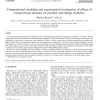Free Online Productivity Tools
i2Speak
i2Symbol
i2OCR
iTex2Img
iWeb2Print
iWeb2Shot
i2Type
iPdf2Split
iPdf2Merge
i2Bopomofo
i2Arabic
i2Style
i2Image
i2PDF
iLatex2Rtf
Sci2ools
IJMMS
2006
2006
Computational modeling and experimental investigation of effects of compositional elements on interface and design aesthetics
This article describes computational modeling and two corresponding experimental investigations of the effects of symmetry, balance and quantity of construction elements on interface aesthetic judgments. In the first experiment, 30 black and white geometric images were developed by systematically varying these three attributes in order to validate computational aesthetic quantification algorithms with subject ratings. The second experiment employed the same image layout as Experiment 1 but with realistic looking web pages as stimuli. The images were rated by 16 subjects in each experiment using the ratio-scale magnitude estimation method against a benchmark image with average balance and symmetry values and a standard number of elements. Subjects also established an ordered list of the images according to their aesthetic appeal using the Balanced-Incomplete-Block (BIB) ranking method. Results from both experiments show that subjects are adept at judging symmetry and balance in both th...
Aesthetic | Aesthetic Appeal | IJMMS 2006 | Images |
Related Content
| Added | 12 Dec 2010 |
| Updated | 12 Dec 2010 |
| Type | Journal |
| Year | 2006 |
| Where | IJMMS |
| Authors | Michael Bauerly, Yili Liu |
Comments (0)

